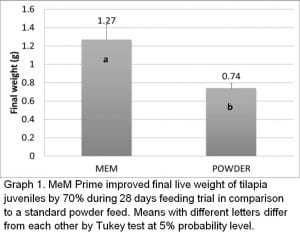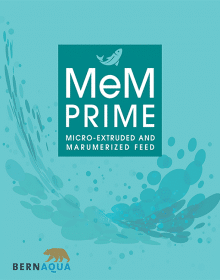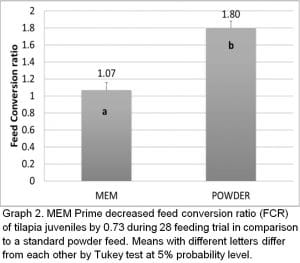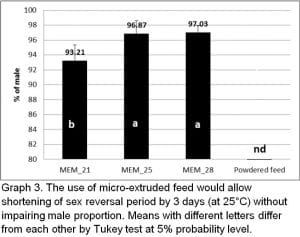MeM Prime, the feeds able to optimize your Tilapia’s production.
26 June 2019
The development of the aquaculture industry is related to several factors, including the production of high quality juveniles. Even in the most common produced species, such as tilapia, mortality rates are often high or variable, and the growth is not always maximized.
For years, the tilapia’s productions were incorporating new techniques and practices, new management on the water quality, new types of tank, use of microorganism, etc.
Moreover, were also developed new genetic strains bringing better growth rates and resistance against diseases. All these incorporations in the management developed the quality and yield of Tilapia in commercial activities.
All this evolution in the Tilapia’s production is demanding new techniques of feeding and new nutritional performance. For years, the use of mashed feed has been used largely on the Tilapia’s fry production, limiting some productivity values as feed conversion and grow up.
Mashed feed or powder feed is commonly used in tilapia juveniles at the initial stage and usually results in satisfactory performances, although those feeds may not meet the nutritional requirements of the species and can deteriorate water quality due to its physical characteristics. Powder feeds have a quick dispersion in the water and a high nutrient leaching which makes its availability for the fish difficult.
The production of MeM Prime involves the technology of cold micro-extrusion and marumerization, and can ensure high water stability of soluble and insoluble nutrients in the feed while avoiding the use of chemical binders. In addition, cold micro-extrusion avoids high temperature during the production process and keeps high vitamins levels and digestibility of nutrients.
Results in experimental facilities and also in customers, indicate that MeM Prime is a very promising alternative to powder feed during early stages of tilapia farming, to improve tilapia performances. Feeding MEM could improve growth rate by 80% and reduce feed conversion ratio by 40%.
Other results obtained using MeM Prime were conducted at Tilapicultura laboratory in CAUNESP (Centro de Aquicultura da UNESP, Universidade Estadual Paulista, Brazil) to see the efficiency during the sex-reversal.
Feeds were coated with 17 alfa-methyltestosterone during the 21, 25 or 28 first days according to the group (MEM_21, MEM_25 and MEM_28 respectively) and with non-coated MeM until the end of the experiment at 28 days.
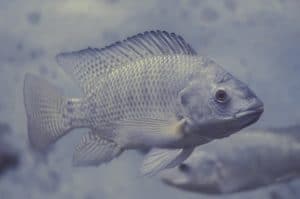
The experiment demonstrate that feeding tilapia larvae with high quality microextruded feed is definitely a good technical strategy to improve fish performances and supply strong larvae at the end of the sex-reversal period. It would also allow farmers to shorten this period, and thus increase productivity through more cycles per year.


